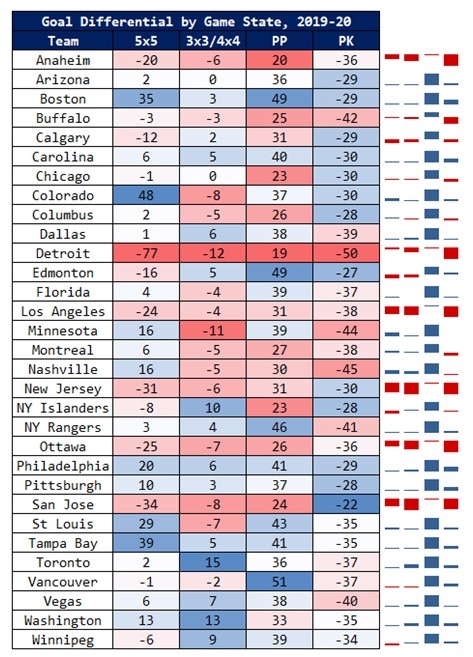Mar 9, 2020
Oilers thriving as a statistical outlier
Edmonton’s special teams are carrying the load for a team that has average goaltending and struggles mightily at 5-on-5, Travis Yost writes.
By Travis Yost

Just how good are the Edmonton Oilers?
We have spent a lot of time this year dissecting the Pacific Division, knowing full well that at least one team would emerge from the group’s muddied middle as a bona fide playoff contender. No team has taken greater advantage of the California teams collapsing and the Calgary Flames’ regression than the Edmonton Oilers, who are now virtually guaranteed to reach the postseason.
In the modern era of hockey (2007-2020) there have been two lead indicators of whether or not a team would chase down a playoff seed: how the group played at 5-on-5 and how well the goaltending would stand up over the course of a season. Those lead indicators don't exactly hold true for Edmonton, and yet their position in the standings is quite favourable, if unconventional.
Through the weekend, the Oilers are 25th in goal differential at 5-on-5 – just four goals better than the lowly Anaheim Ducks, for frame of reference. To say it another way: for every 60 minutes of play at 5-on-5 the Oilers are down about 0.3 goals. That’s significant. (Colorado, on the other hand, is 0.9 goals better than their opponent).
The goaltending has been stable enough to avoid a standings collapse, but not nearly enough to wash away the goal differentials above. The Mikko Koskinen - Mike Smith tandem is 27th in save percentage at 5-on-5 (91.1 per cent), and 14th in all situations (90.5 per cent). If you notice the shift, you notice the story: special-teams play in Edmonton has been mind-bogglingly effective.
If you look at team goal differential by game state, you can see just how much of a statistical outlier the Oilers are:

Edmonton’s power play is getting a lot of media attention lately, but we might still be understating their productivity. It’s the second most efficient power play we have seen in the modern era – their 10.8 goals per 60 minutes trail only the 2018-19 Tampa Bay Lightning (11.1).
What’s fascinating about the Oilers power play is that five players – Leon Draisaitl, James Neal, Connor McDavid, Ryan Nugent-Hopkins and Alex Chiasson – cover 90 per cent of Edmonton’s scoring on the man advantage. The team’s first power-play unit is scoring a whopping 12.5 goals per 60 minutes; the league’s second-best unit (Boston’s first power-play group) is around 11.0.
But the power play isn’t the only dominant unit. The penalty kill has been just as good. The Oilers have the league’s second best kill unit at 5.0 goals per-60 minutes; just decimal points behind the San Jose Sharks.
This year’s team is much more capable at attacking the run of play in the neutral zone through a slew of higher-end skaters (including Riley Sheahan, Josh Archibald, the aforementioned Nugent-Hopkins, and a four-man defensive rotation that includes 22-year-old Ethan Bear) who can gamble and recover more effectively. The underlying numbers aren’t as convincing for the penalty kill – the Oilers are 22nd in expected goal rates against, as an example – but the goaltending tandem of Smith and Koskinen have been outstanding in bailing the kill out when needed.
All in, the Oilers are +27 in goal differential away from 5-on-5, which all but explains why they are headed for a playoff berth. It did raise another interesting question though: Are there other historical examples of teams who siphoned off so many goals at 5-on-5, but were able to win them back and then some in far fewer special teams’ minutes?

The good news for Oilers fans is that this team isn’t mythical – we have seen a number of teams over the years drive their way into the postseason on the backs of an elite power play, elite penalty kill or some combination of the two. But outside of the 2007-08 Philadelphia Flyers, these teams have had limited success in the postseason.
And that’s where the million-dollar question manifests. There should be no questions about whether or not Edmonton is good enough to compete amongst the league’s 16 best teams. But for a group that struggles at 5-on-5, do they have the personnel to beat some of the Western Conference teams that are sensational in that area? Vegas poses a serious problem for Edmonton within the division; Colorado and St. Louis similarly out of the Central. If depth and defensive issues ultimately do sink this team, it’s going to be there.
The saving grace is that Edmonton’s chance of playing any of those three teams in the first round is only about one in six. If that holds, the Oilers may be well-situated to both reach the playoffs and advance beyond the first round.
Data via Natural Stat Trick and Hockey Reference

